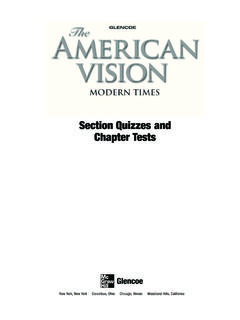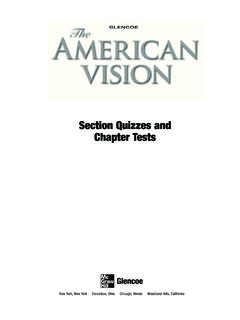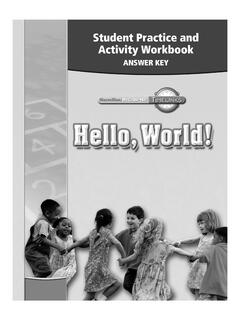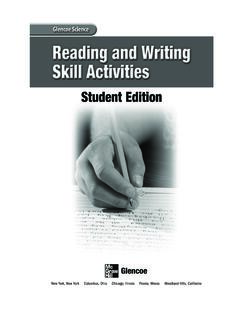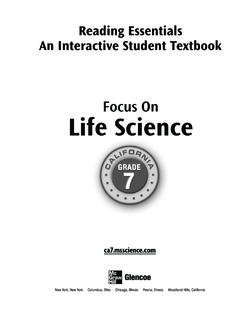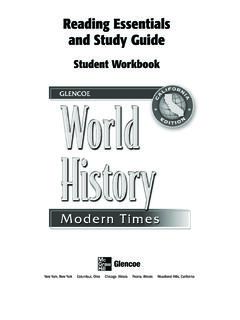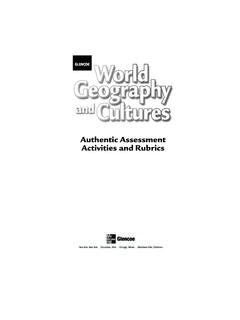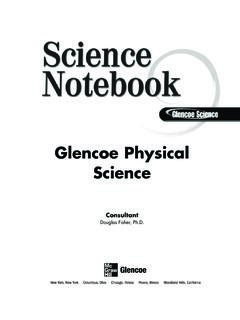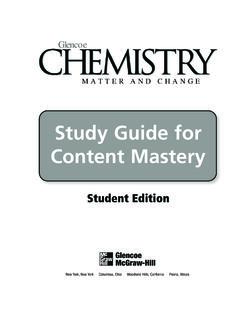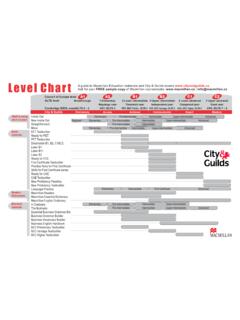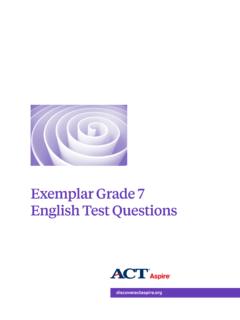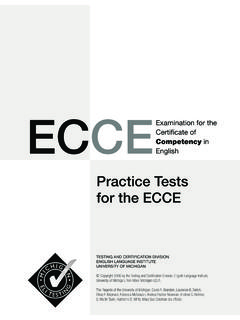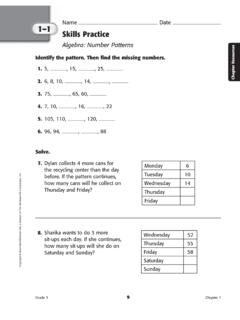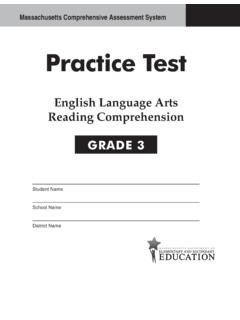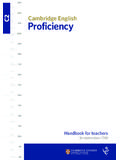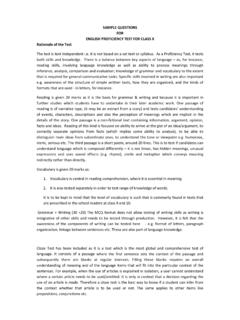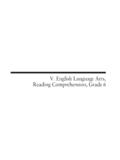Transcription of GLENCOE SOCIAL STUDIES SAT/SAT II
1 Help students prepare for success when takingthe SAT and SAT II testsAuthorThe Princeton ReviewGLENCOE SOCIAL STUDIESSAT/SAT IIPRACTICE BOOKC opyright by the McGraw-Hill Companies, Inc. All rights reserved. Permission is granted to reproduce the materialcontained herein on the condition that such material be reproduced only for classroom use; be provided to students, teachers,and families without charge; and be used solely in conjunction with GLENCOE products. Any other reproduction, for use or sale,is prohibited without prior written permission of the all inquiries to: GLENCOE /McGraw-Hill936 Eastwind DriveWesterville, OH 43081 ISBN 0-07-820397-XPrinted in the United States of America1 2 3 4 5 6 7 8 9 066 03 02 01 00 99 ACKNOWLEDGEMENTSG rateful acknowledgment is made to the following for permission to reprint copyrighted material:Excerpt from Hiroshima by John Hersey. Copyright 1945 by John Hersey. Reprinted by permission of Alfred A.
2 Knopf, from The Name Above the Title: An Autobiographyby Frank Capra. Copyright 1971 by Frank Capra. Reprinted by permission of The macmillan from The Dust Bowl: The Southern Plains in the 1930s by Donald Worster. Copyright 1979 by Oxford UniversityPress, Inc. Reprinted by permission of Oxford University Press, from The Spanish Armada: The Experience of War in 1588 by Felipe Fernandez-Armesto. Copyright 1988 byFelipe Fernandez-Armesto. Reprinted by permission of Oxford University Press, : Every effort has been made to locate the copyright owner of material reprinted in this book. Omissions brought to ourattention will be corrected in subsequent THE TEACHERThe SAT/SAT II Test Practiceis designed to provide instruction and practice in the types of questionsfound on standardized achievement tests . The practice tests closely parallel the format and approachused on the new SAT I: Reasoning Test and SAT II: Subject tests .
3 The 38 lessons in this bookletprovide instruction and practice in the following kinds of SAT I questions: analogy, sentencecompletion, critical reading, mathematics, quantitative comparison, and grid-in questions. Inaddition, instruction and practice is also provided for the SAT II: Writing Test, the SAT II: AmericanHistory and SOCIAL STUDIES Test, and the SAT II: World History booklet was written by The Princeton Review, the nation s leader intest preparation. Through its association with GLENCOE /McGraw-Hill, ThePrinceton Review offers the best way to help students excel on the SAT andSAT II Princeton Review is not affiliated with Princeton University or Educational Testing Service. CONTENTSL esson 1:An Overview of the SAT I and SAT II1 Lesson 2:SAT I Analogy Questions3 Lesson 3:Strategies for Solving SAT I Analogy Questions I5 Lesson 4:Strategies for Solving SAT I Analogy Questions II7 Lesson 5:Strategies for Solving SAT I Analogy Questions III9 Lesson 6:Practice in Solving SAT I Analogy Questions11 Lesson 7:SAT I Sentence Completion Questions13 Lesson 8:Strategies for Solving SAT I Sentence Completion Questions I15 Lesson 9:Strategies for Solving SAT I Sentence Completion Questions II17 Lesson 10: Practice in Solving SAT I Sentence Completion Questions19 Lesson 11: SAT I Critical Reading Questions21 Lesson 12: Strategies for Solving SAT I Critical ReadingQuestions I23 Lesson 13: Strategies for Solving SAT I Critical Reading Questions II29 Lesson 14: Strategies for Solving SAT I Critical ReadingQuestions III35 Lesson 15.
4 Strategies for Solving SAT I Critical Reading Questions IV41 Lesson 16: Practice in Solving SAT I Critical ReadingQuestions49 Lesson 17: SAT I Mathematics Questions57 Lesson 18: Strategies for Solving SAT I Multiple-Choice Mathematics Questions I59 Lesson 19: Strategies for Solving SAT I Multiple-Choice Mathematics Questions II61..Lesson 20: Practice in Solving SAT I Multiple-ChoiceMathematics Questions63 Lesson 21: SAT I Quantitative Comparison Questions65 Lesson 22: Strategies for Solving SAT I Quantitative ComparisonQuestions 67 Lesson 23: Practice in Solving SAT I Quantitative ComparisonQuestions69 Lesson 24: SAT I Grid-In Questions71 Lesson 25: Strategies for Solving SAT I Grid-In Questions73 Lesson 26: Practice in Solving SAT I Grid-In Questions75 Lesson 27: SAT II Writing Test Questions77 Lesson 28: Strategies for Answering SAT II Writing Test Essay Questions79 Lesson 29: Strategies for Solving SAT II Writing Test Error Identification Questions 83 Lesson 30: Strategies for Solving SAT II Writing Test SentenceCorrection Questions 87 Lesson 31.
5 Strategies for Solving SAT II Writing Test Revision-in-Context Questions 91 Lesson 32: Practice in Solving SAT II Writing Test Questions95 Lesson 33: SAT II The American History andSocial STUDIES Test 99 Lesson 34: Strategies for Answering The American History and SOCIAL STUDIES Test Questions103 Lesson 35: Practice in Solving SAT II American History and SOCIAL STUDIES Test Questions105 Lesson 36: SAT II World History Subject Test Questions109 Lesson 37: Strategies for Solving SAT II World History Subject TestQuestions113 Lesson 38: Practice in Solving SAT II World History Subject TestQuestions115 Answer Key119..NAMEDATECLASSAN OVERVIEW OF THE SAT I AND IIThe Scholastic Assessment tests consist of the SAT I: Reasoning Test and 22 different SAT II: SubjectTests. The SAT I tests vocabulary and reading in its verbal sections; its mathematics sections coverarithmetic, algebra, and geometry. The SAT II tests specific book will help you prepare for the SAT I: Reasoning Test and for three of the SAT II: Subject tests the Writing Test, the American History and SOCIAL STUDIES Test, and the World History Test.
6 The SAT I:Reasoning Test contains seven sections, as follows: 3 Verbal Reasoning sections, consisting of multiple-choice analogy, sentence completion, and criticalreading questions 3 Mathematics Reasoning sections, consisting of multiple-choice questions, grid-in questions, andmultiple-choice quantitative comparisons about arithmetic, algebra, geometry, and suchmiscellaneous topics as probability and data interpretation 1 experimental section (either Verbal or Mathematics), which will not be counted as part of yourscore (It is used to try out questions for future tests .)The three SAT II: Subject tests discussed in this book contain other kinds of questions: The SAT II Writing Test: An essay question plus 60 multiple-choice questions covering erroridentification, sentence correction, and revision-in-context issues The SAT II American History and SOCIAL STUDIES Test: 90 95 multiple-choice questions thatemphasize American history from pre-Columbian times to the present The SAT II World History Test: 95 multiple-choice questions that emphasize major world culturesand basic historical techniquesPREPARING TO TAKE THE SAT I AND SAT IIThe most important preparation for either the SAT I or the SAT II is practice.
7 The more you practice, themore familiar you will become with test directions and the kinds of questions that are likely to appear onthe test you take and the better the chance of doing well. This book provides practice for every type ofquestion that appears on the SAT I: Reasoning Test and three of the SAT II: Subject tests . As you workthrough it, you will learn: To understand the instructions for each different type of question To allocate your test time effectively To use some simple strategies to maximize your test scores To use the process of elimination to select the correct answer To mark your answer sheet properly, so you get credit for all your correct answers To gain confidence in your test-taking abilitiesCoverage of each kind of question includes an introduction to the question format, specific strategies foranswering that type of question, and additional practice. Don t stop when you think you have learnedhow to answer one type of question; rather, continue until you have answered all the questions in everylesson.
8 Then you can go on to take practice tests under timed conditions. Previously administered SATsare the best full-length practice tests you can by The McGraw-Hill Companies, SIMPLE STRATEGIES FOR TAKING THE SAT I AND SAT IIYou will find specific advice about strategies for each type of question in the lessons to come. Here aresome simple general strategies that will also all the questions you are sure of before you spend time on the questions you find is to get the largest number of correct answers that you can, so make sure that you giveyourself the time to answer all those you know. On your test booklet, mark the questions youaren t sure of, and cross out the answer choices you have eliminated, so you can return to thosequestions later and work out your answers. Most groups of questions of the same type areorganized so that they start out with easy questions and work up to more difficult ones. questions and difficult questions offer the same amount of easy questions carefully,then go on to questions of medium difficulty, and work slowly and carefully on those, as sections are timed so that most people will have to rush to finish, and that causes carelesserrors.
9 Unless you are trying to score above 650 in either Math or Verbal, you should not finish asection. You should leave the most difficult questions blank, and be sure you answered the easyand medium questions correctly. If you find you have time left, then you can try some of the mostdifficult To find the right answer, eliminate all the wrong answers. When you take the SAT I or an SAT II,try to think like a detective solving a crime. You may not be sure of the right answer, but usuallyyou can be certain that some of the answers are wrong. In your test booklet, immediately crossout the answer choices that are wrong, so you can focus only on the choices that might be technique can reduce the time you spend on the question; it also can help you focus on thereal when to guess and when to skip a a multiple-choice question gives you fivepossible answers, then, ideally, you may be able to eliminate the four wrong choices and selectthe right answer.
10 If that is not the case, follow these guidelines: If you can eliminate three wrong answers, leaving two possibles, your chance of guessing theright answer is 50%. Your best strategy is to guess, marking your answer sheet with one of thetwo possibles. When you guess correctly (as the law of averages says will happen in abouthalf the cases), you will gain a point. When you guess incorrectly, you will lose only a fractionof a point (one-fourth of a point if there are five answer choices). Therefore, guessing theanswer from two possibles is statistically likely to maximize your score. If you can eliminate two wrong answers, leaving three possibles, your chance of guessing thecorrect answer is 33%. If you can eliminate two wrong answers, leaving three possibles, yourchance of guessing the correct answer is 33%. Again, your best strategy is to guess from amongthe three remaining answer choices. When you guess correctly, you will gain one point; whenyou guess incorrectly, you will lose only one-fourth of a point.
